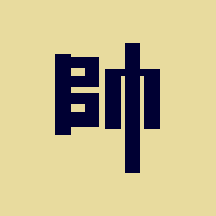 christopher oehler
christopher oehler
Keywords: general eo jae-yeon | chinese su: 帥 | chinese wonsu: 元帥 |
Links: FOTW homepage | search | disclaimer and copyright | write us | mirrors

Last modified: 2021-08-24 by  christopher oehler
christopher oehler
Keywords: general eo jae-yeon | chinese su: 帥 | chinese wonsu: 元帥 |
Links: FOTW homepage |
search |
disclaimer and copyright |
write us |
mirrors
 image by Eugene Ipavec, 27 October 2007
image by Eugene Ipavec, 27 October 2007
See also:
After 136 years, the rank flag of General Eo Jae-yeon (1823-1871) was returned to the South Korean Cultural Heritage Administration. The flag is on loan from the U.S. Naval Academy Museum, which has had possession. The flag was captured as a war trophy in 1871, when the U.S. Expedition to Korea captured the flag in 1871 when American troops seized Ganghwa Island.
General Eo was the commander of the Gwgangseong Garrison on Gangwa Island in 1971 and was killed in action along with 430 Korean soldiers.
The flag is believed to be made of hemp or cotton and is 4.5 square meters.
It will be on loan to the Korean government for up to 10 years. It bears the lettering in Chinese
that stands for "commanding general." The flag was restored in 1913.
adapted from news reports contributed by Ivan Sache, 27 October 2007
The article in Korea Times
says the flag is "regarded as a rare and crucial military
source called 'sujagi' - the general's flag - which was used in the
field and at the main gate of the barracks at the end of the 19th
century."
Eugene Ipavec, 27 October 2007
The flag bore the Hanja (Chinese ideogram) "su" (帥), which is short for
"wonsu" (元帥), meaning "Field Marshal".
Miles Li, 8 November 2007
The flag referred to here is the 수자기 (English: "Sujagi, Sujabi or Suigi"), a
flag with a Hanja (Chinese ideogram) 帥, pronounced su in Korean, that denotes a
commanding general. The whole term literally means, "Commanding general flag".
Only one sujagi is known to exist in Korea. The color is a faded yellowish-brown
background with a black character in its center. It is made of hemp cloth and
measures approximately 4.15m x 4.35m.
This type of flag was put in a
fortress where a commanding general was located. In the case of the extant
sujagi in Korea, it represented General 어재연 (English: Eo Jae-yeon (also spelled
Uh Je-yeon)) who, in 1871, commanded the Korean Rebellion Army on Ganghwa
Island, which is off the northwest coast of present-day South Korea, near the
capital of Seoul. It was captured after the three-day Battle of Ganghwa by the
United States Asiatic Squadron in June of that year during the United States'
expedition to Korea (Korean: 신미양요, English: Shinmiyangyo). As with other war
prizes, it was put into the collection of the museum at the United States Naval
Academy in Annapolis, Maryland.
Under a loan, it was returned and it is
currently displayed at the 국립고궁박물관 (English: National Palace Museum (of Korea))
in Seoul, 136 years after the icon was seized by invading U.S. troops, in
response to requests from South Korea's Cultural Heritage Administration,
starting on October 10, 2007. The agreement would cover up to 10 years (to be
over/renewed in 2017) .
Sources:
https://news.usni.org/2017/12/15/kim_jong_un_flags_usna,
https://en.wikipedia.org/wiki/Sujagi
Here are other pictures of the flag, aboard the USS Colorado when it was
captured:
-
https://news.usni.org/wp-content/uploads/2017/12/Korean-flags-Captured-flag-with-US-Marines.jpg
(source:
https://news.usni.org/2017/12/15/kim_jong_un_flags_usna)
-
http://www.shinmiyangyo.org/kwg46.jpg (source:
http://www.shinmiyangyo.org/beato.html)
-
http://www.homeofheroes.com/talkingpoints/images/corean_flag.jpg (source:
http://www.homeofheroes.com/talkingpoints/0510_USSPueblo.html)
And
here are some pictures of the flag being displayed:
-
http://img.koreatimes.co.kr/upload/news/071105_p14_top.jpg (source:
https://www.koreatimes.co.kr/www/news/people/2012/11/178_13169.html)
-
https://www.stripes.com/polopoly_fs/1.70269.1273636925!/image/468986582.jpg_gen/derivatives/landscape_900/468986582.jpg
(source:
https://www.stripes.com/news/general-returns-on-loan-to-korea-1.70260)
-
http://pds.joins.com/news/component/htmlphoto_mmdata/200812/htm_20081230005634a000a100-001.JPG
(source:
http://news.joins.com/article/3438223)
It is worth noticing that
during this incident (the 1871 battle) happened during the existence of the 대조선국
(English: "Kingdom of Great Joseon") (1392-1897) (https://en.wikipedia.org/wiki/Joseon)
they already had a flag, which is already featured here: "Eight
Kwae". It is a de facto State flag since it was the personal Standard of the
King of the Joseon dynasty.
Esteban Rivera, 26 December 2018